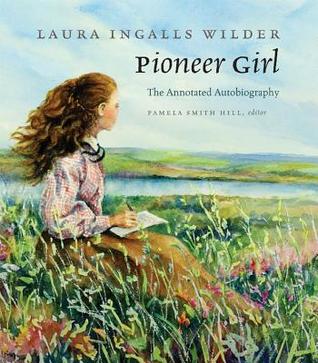Pioneer Girl: The Annotated Autobiography

Summary (from the publisher): Pioneer Girl follows the Ingalls family's journey through Kansas, Missouri, Wisconsin, Minnesota, Iowa, back to Minnesota, and on to Dakota Territory sixteen years of travels, unforgettable experiences, and the everyday people who became immortal through Wilder's fiction. Using additional manuscripts, letters, photographs, newspapers, and other sources, award-winning Wilder biographer Pamela Smith Hill adds valuable context and leads readers through Wilder's growth as a writer. Do you think you know Laura? Pioneer Girl: The Annotated Autobiography will re-introduce you to the woman who defined the pioneer experience for millions.
Review: Before she was the author of the beloved and bestselling young adult series Little House, Laura Ingalls Wilder wrote a non-fiction account of her life growing up in the American West. Handwritten on six tablets, this manuscript covered Wilder's life between the ages of two and eighteen and followed the Ingalls family through Kansas, Missouri, Wisconsin, Minnesota, Iowa, back to Minnesota, and in the Dakota Territory in the years 1869 to 1888. Although Wilder wished to publish this autobiography, by the time she had completed drafting it, the Great Depression had all but put a halt to publishing companies purchasing new manuscripts. Over time, her daughter Rose Wilder Lane helped use the material in the original autobiography to craft a series of young adult books that ultimately become the beloved bestsellers. Now, nearly eighty years after it was first written, Wilder's original autobiography, the basis for the best selling books, can also be enjoyed.
The inclusion of the word "annotated" in the title of this book is certainly no understatement. This book is bursting at the seams with elaborate and detailed annotations in the margins. In fact, because of the number and depth of the annotations, the physical size of this book is large and rather daunting. However, Wilder's original manuscript, printed here as closely to the original as can be pieced together, was written without chapter breaks, with some errors in time and dates, with few explanations for who individual people mentioned are, and with little historical reference. Thus reading both the autobiography and the many editorial notes gives the reader a much deeper and fuller understanding of Laura's childhood. Additionally, the annotations points out stories or details that were changed in the novels and the rationale for such departures from factual events. However, at times the annotations did feel a tad overboard. The editors went to some pains to attempt to track down every individual referenced by Laura, which was nice information to have but not necessarily critical for understanding, particularly when it was simply a passing reference to a school playmate.
For readers who enjoyed Wilder's fiction, this work of non-fiction reveals the many incidents in Laura's childhood that must have been deemed inappropriate or too adult for inclusion in the novels. For instance, Laura had a infant brother Freddie who died tragically young. He never appears in the novels, but is maintained in this original writing. Neighbors and townspeople get drunk at local saloons and spousal abuse between neighbors occur. At one point as a young teenager, Laura takes a job boarding with a family to help care for their baby and to assist with housekeeping. One night, the husband seemingly attempts to molest Laura, leading to Laura quitting the next day. It's rather obvious why these episodes were omitted for the children's books. On the other hand, despite flaws in the community in which Laura lives, after reading this, my esteem for Laura and her family were in no way altered from the original impression I had after reading the novels.
Reading this book helped me relive the experience of Laura and Mary and Ma and Pa in the famous novels, but with a more adult perspective and new details. For example, I loved learning that Caroline Quiner and Charles Ingalls were one of three sibling pairs; Polly Ingalls and Henry Quiner as well as Peter Ingalls and Eliza Quiner married. This interesting triple integration of the two families gave Laura and her sisters two sets of "double cousins." I also loved learning more details about how the family survived the long winter of 1881.
As the editor notes in the conclusion, this book "presents new insights into Wilder's past, but it also helps to document her growth as an important American artist who grew from farm journalist to novelist to literary legend" (328). Although this book is massively appealing as a companion non-fiction work to the novels, it also has incredible value as a history of life in the west during the late nineteenth century.
Stars: 4. 5


Comments
Post a Comment